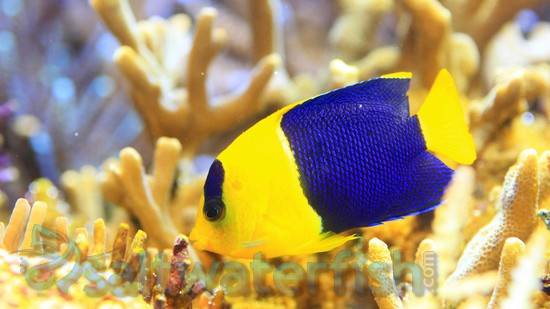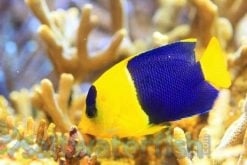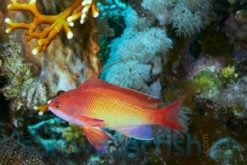Quick Stats:
- Care Level: Moderate
- Temperament: Semi-aggressive
- Diet: Omnivore
- Reef Safe: With Caution
- Minimum Tank Size: 70 gallons
- Max Size: 6 inches
- Water Parameters: pH 8.1-8.4, Salinity 1.020-1.025, Temperature 72-78°F
Comprehensive Guide: Bicolor Angelfish (Centropyge bicolor)
Habitat:
The Bicolor Angelfish is native to the Indo-Pacific region, specifically found in the reefs of the Maldives, Indonesia, and the Great Barrier Reef. It prefers areas with plenty of hiding spots and coral growth.
Reef Safe:
The Bicolor Angelfish is generally considered reef-safe with caution. While it usually leaves corals alone, it may nip at some soft and stony corals. It is best to monitor their behavior closely if they are kept in a reef tank.
Size:
The Bicolor Angelfish can grow up to 6 inches long, making it a suitable choice for medium-sized aquariums.
Temperament:
This species is semi-aggressive and may become territorial. It is generally peaceful towards other fish but may show aggression towards similar-looking species or smaller tankmates.
Sexual Dimorphism:
There are no visible differences between males and females regarding coloration or physical characteristics.
Lifespan:
The average lifespan of the Bicolor Angelfish is around 5 to 10 years with proper care and a suitable environment.
Diet in Aquariums:
The Bicolor Angelfish is an omnivore and should be offered a varied diet. It should be fed a combination of high-quality flakes, pellets, frozen foods (such as brine shrimp and mysis shrimp), and occasional live foods. Including marine algae and seaweed in their diet is also beneficial.
Aquascaping Recommendations:
Provide plenty of hiding spots and caves using live rock structures. This will help mimic their natural habitat and provide them with places to retreat and feel secure.
Captive Bred Availability:
The Bicolor Angelfish is available as captive-bred specimens, which are generally hardier and more adaptable to aquarium conditions than wild-caught individuals. Captive-bred specimens also help reduce the impact on wild populations.
Compatibility with Tankmates:
The Bicolor Angelfish can be kept with various peaceful to semi-aggressive fish species. However, caution should be exercised when choosing tankmates with similar coloration or body shape, as territorial aggression may occur. Here are five specific tankmates that can be good choices:
- Hippo Tang (Paracanthurus hepatus): A peaceful fish that adds vibrant color to the tank and helps with algae control.
- Ocellaris Clownfish (Amphiprion ocellaris): A popular and hardy species that can form a symbiotic relationship with anemones.
- Firefish Goby (Nemateleotris magnifica): A peaceful and colorful fish that adds movement to the lower levels of the tank.
- Royal Dottyback (Pictichromis paccagnellae): A peaceful fish with beautiful purple and yellow coloration.
- Cleaner Shrimp (Lysmata amboinensis): A helpful invertebrate that cleans parasites off other fish and adds activity to the tank.
Other Common Names:
The Bicolor Angelfish is also known as the Oriole Angelfish or Two-colored Angelfish.
Why Buy from Reefs4Less.com:
Reefs4Less.com is a reputable online retailer specializing in saltwater aquarium supplies. They offer a wide selection of high-quality fish, corals, and equipment. Their products are carefully sourced, and their customer service is top-notch. With Reefs4Less.com, you can trust that you are getting healthy and well-cared-for marine life for your aquarium.
Popular Questions and Answers:
Q: What is the ideal tank size for a Bicolor Angelfish?
A: The minimum tank size for a Bicolor Angelfish is 70 gallons, but a larger tank of 100 gallons or more is recommended to provide ample swimming space.
Q: Can Bicolor Angelfish be kept in a reef tank?
A: Bicolor Angelfish can be cautiously kept in a reef tank. While they leave corals alone, they may nip at some soft and stony corals. It is important to monitor their behavior closely and provide plenty of hiding spots for the corals.
Q: How often should I feed my Bicolor Angelfish?
A: Bicolor Angelfish should be fed in small amounts multiple times a day. Offer a variety of high-quality flakes, pellets, frozen foods, and occasional live foods to ensure a balanced diet.
Q: Can Bicolor Angelfish be kept with other angelfish species?
A: Keeping Bicolor Angelfish with other angelfish species is generally not recommended, especially for those with similar coloration or body shape. They may exhibit territorial aggression towards each other.
Q: How can I introduce a Bicolor Angelfish to my existing aquarium?
A: When introducing a Bicolor Angelfish to an existing aquarium, it is important to acclimate them slowly to the new environment. Use a quarantine tank to observe their behavior and ensure they are healthy before introducing them to the main tank. Gradually introduce them to the main tank over several weeks to minimize stress and aggression.
| Size | 3 – 4 inches |
|---|




Reviews
There are no reviews yet.